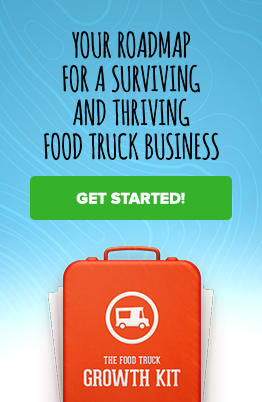A vehicle, a menu, and a place to park—these are the essentials your food truck needs before you can open for business. Once you’re ready to expand, you might branch out by sharing your location through social media and participating in community events. But when should you add a website to the mix?
The answer might be sooner than you think. While a website isn’t quite as important to your bottom line as the creative dishes you’re serving up daily, it does provide a major opportunity to take your food truck business to the next level. According to a 2010 study from the Pew Internet & American Life project, 78 percent of US Internet users research online before buying. Your truck isn’t selling food online, but people are looking for you there. If you don’t have a website where interested customers can check out what you have to offer and where you’re parked this week, you’re missing out on a ton of traffic and potential sales—as well as the opportunity to make a good first impression on new customers.
The FoodTruckr team has checked out hundreds of food trucks online, and we see a lot of trucks using their Facebook and Twitter pages in place of formal websites. It’s easy to understand why: social media is free to use and requires little technical knowledge to get started. You can easily use Facebook and Twitter to share photos of your food and to tell people where you’re heading next. However, these tools don’t give you the same type of control and flexibility that a website can.
A professional website boosts your credibility and draws in more customers through organic search traffic. Your website also helps you connect positively with people who aren’t familiar with your truck—and incentivizes customers who are trying to decide whether to have lunch at your truck or another. Check out the top four ways a website takes your food truck business to the next level.
1. Get Customers (and Respect) Through the Magic of Google
How do customers find your truck for the first time? Some people probably see you on the street, and some might go to your website because they have a friend who keeps raving about your incredible menu. Others will find you by going to Google and searching for food trucks or a particular type of cuisine in your city. In the end, it doesn’t matter how people find your truck—it only matters that you make it easy for them to do so.
Having a website in place dramatically increases your online visibility. Here’s why: Google and other search engines use complex algorithms to determine which websites should appear first when a user searches for a given term. By using SEO (search engine optimization) strategies on your website, you can improve your ranking and appear higher in the search results.
Why do high search results matter? Well, think about all of the times you’ve searched for something on Google. How often do you view the second page of results? In fact, how often do you even make it to the bottom of the first page? People believe the top results will have the answers they’re looking for—and they automatically put trust in the businesses that are featured there.
Though you can use SEO tactics to boost the results for your Facebook page or Twitter profile, you’ll get much better results from an optimized website. And if your truck is one of the first few results to appear for “food trucks in [your city],” new customers will find you easily on their own.
2. Keep the Competition Out
Facebook is free to use, but they have to get money somewhere—and ads make up one of the social network’s greatest revenue streams. That means it’s highly likely that a competitor’s ad could show up on your customer’s screen while he or she is viewing your page. If you don’t want people getting wooed away by a competing truck’s flashy slogans or by a 2-for-1 special from a local restaurant chain, you need to keep them focused on all the goodness your truck has to offer.
So, how do you capture their interest? For starters, it helps to get people off Facebook and Twitter and onto your website. Once they’re in your house, you have their sole attention—and the chance to excite their taste buds through your website’s photos and stories.
3. Ensure That Your Customers Can’t Wait to Get a Taste
When used correctly, Facebook and Twitter are fantastic marketing channels—but they aren’t substitutes for the type of brand experience you can create with a website.
On major social networks, it’s too easy for your fans to get distracted when you want them to be paying attention to your truck’s page. While you might customize your Facebook page and Twitter profile through tools like the cover photo and background image, you’ll always be competing with the site’s own branding, as well as all of the other users and pages who are sharing content. With a website, you have the space all to yourself, which allows you to immerse users in the experience and values of your truck.
Use your website to inspire customers to visit your food truck. Remember, nearly 80 percent of people check out a business’s website before deciding to visit—so it’s your job to incite cravings in those new customers. Share your story and tell people how your truck got started. Post your menu along with photos of the food and fans lined up just to get a taste. Update your page with your location and news about your truck’s next big moves.
Seattle-based I Love My GFF does a great job of showing customers what their business is all about—healthy, convenient, gluten-free food. From the bright colors and fresh photos on the homepage to the Rave Reviews page featuring more than 25 satisfied customers, the I Love My GFF website is simple, effective, and fun. New visitors to the page can clearly see right away why they should choose a nutritious and delicious I Love My GFF bowl.
When people visit your website, they should get a sense of who you are and what it’s like to visit your truck. By accurately conveying that experience, you’ll get more people seeking you out and making a special trip just to see what all the online buzz is about.
4. Make Your Own Rules
You wouldn’t give the keys to your truck to another company and trust them to drive you around to the best local selling spots, would you? Well, you shouldn’t trust Facebook or Twitter with the keys to your online presence, either.
You probably don’t need to worry about these major social players going offline anytime soon, but you should be concerned about giving control of a portion of your food truck business to another company. Facebook in particular is well-known for making changes to their policies and page designs without giving users more than two or three weeks of notice. If the social network you’re using as your main online presence decides to institute a new policy that negatively impacts your page—or if you inadvertently violate their complex Terms of Service—your truck’s page could be temporarily banned or removed from the site altogether.
On the other hand, when you have your own website, you’re always in control and you’ll never need to worry about someone pulling the plug on all your hard work. You can post anything and design your page to look however you want because you’re in charge of making the rules.
Show Customers What You’ve Got
Of course, a website isn’t an all-in-one solution that will magically bring long lines to your truck—the hard part is up to you. Creating loyal fans who will return over and over and bring their friends is all about the quality of your food, the service you offer, and your power to connect with people.
However, a website does serve as an online version of your truck where people can get to know you and see what you have to offer. And most importantly, your website is an opportunity for you to show your customers that you’re doing something different (or better) than anyone else in your area.
Stay tuned to FoodTruckr to learn about the most important qualities your website should have—and the easiest and most affordable ways to develop an effective online home for your truck. Our Resources page has a list of tools to help get your website started.
In the meantime, we’d love to know how you’re using your website or social media pages to attract new fans. What does your website do to convince people they should visit your truck? Tell us about your experiences in the comments below or share your thoughts on our Facebook page!
image by joguldi
There is no ads to display, Please add some


